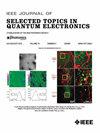Topological Multi-Mode Photonic Crystal Fiber
IF 5.1
2区 工程技术
Q1 ENGINEERING, ELECTRICAL & ELECTRONIC
IEEE Journal of Selected Topics in Quantum Electronics
Pub Date : 2025-06-13
DOI:10.1109/JSTQE.2025.3579625
引用次数: 0
Abstract
Topologically-protected optical fiber is thought to significantly reduce the backscattering effects caused by the defects or impurities during the light propagation along the fiber length. The Zak phase is a topological invariant that characterizes the phase change of the wave function over one period in a periodic system. Here, we realize the topological transition of two-dimensional Zak phases by tuning the distribution of scattering columns at the propagation constant kz > 0, and demonstrate the corner states formed by the coupling of edge states as the guiding modes of the fiber. This topological guiding mode exhibits a strong localization with an ultra-small mode-field area of 0.3 μm2 (or high nonlinearity) and low confinement loss of ∼ 10−7 dB/km at 1.55 μm. Moreover, the multi-mode nature of this topological fiber is demonstrated by the realization of corner state modes located in the high-order topological bandgap at kz > 0. The high-order corner state modes perfectly match with the results obtained by the mode analysis based on finite element method. This topological multi-mode fiber holds a promise in short-distance backscattering-immune propagation and the nonlinear applications.拓扑多模光子晶体光纤
拓扑保护光纤被认为可以显著降低光在沿光纤长度传播过程中由缺陷或杂质引起的后向散射效应。Zak相位是表征周期系统中波函数在一个周期内的相位变化的拓扑不变量。在这里,我们通过在传播常数kz > 0处调整散射柱的分布来实现二维Zak相位的拓扑跃迁,并证明了由边缘态耦合形成的角态作为光纤的引导模。该拓扑引导模式具有很强的局域性,模场面积小至0.3 μm2(或高非线性),约束损耗低,在1.55 μm处为~ 10−7 dB/km。此外,该拓扑光纤的多模特性通过位于高阶拓扑带隙的角态模式的实现得到了证明。高阶角态模态与基于有限元方法的模态分析结果吻合良好。这种拓扑多模光纤在近距离抗反向散射传播和非线性应用中具有广阔的应用前景。
本文章由计算机程序翻译,如有差异,请以英文原文为准。
求助全文
约1分钟内获得全文
求助全文
来源期刊

IEEE Journal of Selected Topics in Quantum Electronics
工程技术-工程:电子与电气
CiteScore
10.60
自引率
2.00%
发文量
212
审稿时长
3 months
期刊介绍:
Papers published in the IEEE Journal of Selected Topics in Quantum Electronics fall within the broad field of science and technology of quantum electronics of a device, subsystem, or system-oriented nature. Each issue is devoted to a specific topic within this broad spectrum. Announcements of the topical areas planned for future issues, along with deadlines for receipt of manuscripts, are published in this Journal and in the IEEE Journal of Quantum Electronics. Generally, the scope of manuscripts appropriate to this Journal is the same as that for the IEEE Journal of Quantum Electronics. Manuscripts are published that report original theoretical and/or experimental research results that advance the scientific and technological base of quantum electronics devices, systems, or applications. The Journal is dedicated toward publishing research results that advance the state of the art or add to the understanding of the generation, amplification, modulation, detection, waveguiding, or propagation characteristics of coherent electromagnetic radiation having sub-millimeter and shorter wavelengths. In order to be suitable for publication in this Journal, the content of manuscripts concerned with subject-related research must have a potential impact on advancing the technological base of quantum electronic devices, systems, and/or applications. Potential authors of subject-related research have the responsibility of pointing out this potential impact. System-oriented manuscripts must be concerned with systems that perform a function previously unavailable or that outperform previously established systems that did not use quantum electronic components or concepts. Tutorial and review papers are by invitation only.
 求助内容:
求助内容: 应助结果提醒方式:
应助结果提醒方式:


